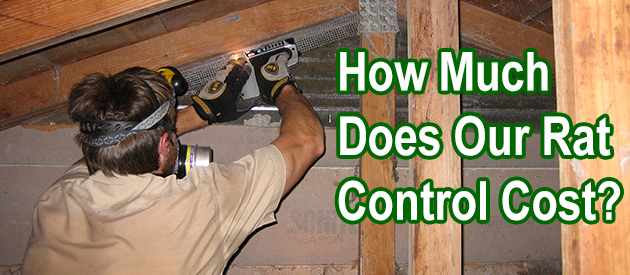Marion County, Indianapolis Rat Control Situation:
Hello David, I have been reading the information that you have on line about squirrels in the attic. We have something in our attic and cannot figure out what it is, nor have we been able to trap it, nor has it been caught in a rat trap. I hear this creature or creatures ??? during the day, as well as at night. There does not seem to be a particular favorite time that they move around. Perhaps the morning is very quiet, and there is more activity in the afternoon and evening. My bedroom is quite a distance from the area that we hear this creature in, so I would not hear it at night even if it is moving around a lot at night.
I mostly have heard scratching in the walls, and at one point did hear a big thud. The odd thing about this creature is this. We set a live trap with peanut butter in it, and what ever it is carried large pieces of insulation inside the trap to cover the peanut butter. Like really large- maybe a 6 X 6 inch piece. We feel the trap was not set properly because it did not shut. Next day we put meat in it, thinking it may be an animal that would want meat like an opossum. All this time our rat traps have remained in place but this creature DAILY overs all the traps with insulation....without getting caught. We have not seen anything enter or leave. We found one area that is gapping between he house and fascia but only maybe a 3" opening. We do know for sure that there is enter way at the garage floor. We will put foam insulation in those areas this weekend to hopefully stop rats or whatever it is up there from entering and will continue our trapping efforts. We live north of Indianapolis IN in the country on one acre. Our house is 7 years old; made of brick.
By my description, do you have any idea what we might be dealing with, and any suggestions on how to catch this creature? I appreciate all the info your web site; I just cant find anything that remotely sounds like what we have going on with this creature attempting to bury the traps with insulation. Many thanks for any advice. Jill
Why don't you have a wildlife expert inspect the house and attic in order to determine what the animal is? It could be raccoons or opossums, not necessarily rats. The feces and tracks in the attic, and the nature of the entry holes should tell you what animal you're dealing with.
Indianapolis Rat Control Tip of The Week
How Do Rats Fit In Small Holes, Do They Have Bones?
Rats Can Truly Fit In Small Holes:
A rat needs a space of just about a half an inch to get into an area. Rats have been known to climb through pipes, through areas in the ceiling, and more. Rats can do quite a lot with very little space and this will lead to the chance that they could end up in your home.
Rats Have Joints And Cartilage Like We Do:
The joints and cartilage that rats have can be very similar to the systems that we have. Rats can often work at strengthening their cartilage and joints when they scurry through small spaces. They strengthen their abilities by dashing through small spaces and this ensures that as long as they stay healthy, they can make it through small spaces.
As They Gain Weight They Face Challenges:
As a rat gains weight from staying close to its food source this can lead to the chance that it can no longer fit through holes roughly the size of a quarter. This can make the process of getting into these areas much more challenging. As a rat improves the size of its abdomen, it often loses its ability to fit through tight spaces.
Rats Sense If They Can Fit With Their Whiskers:
Rats are able to fit through areas because their bodies are extremely flexible and cylindrical. The shape of a rat is designed for burrowing and fitting into tight spaces. Rats are able to determine if their body can fit into an area by using their whiskers. This makes every judgment on going through a tight space much easier.
Rats Don't Have Softer Bones:
The skeleton of a rat is just the same as many other rodents. They have hard bones that don't bend and this will often limit the size of the spaces that they can crawl through.


